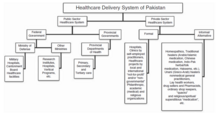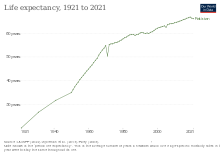This article needs additional citations for verification. (January 2009) |


The healthcare delivery system of Pakistan is complex because it includes healthcare subsystems by federal governments and provincial governments competing with formal and informal private sector healthcare systems.[3][2] Healthcare is delivered mainly through vertically managed disease-specific mechanisms. The different institutions that are responsible for this include: provincial and district health departments, parastatal organizations, social security institutions, non-governmental organizations (NGOs) and private sector.[4] The country's health sector is also marked by urban-rural disparities in healthcare delivery and an imbalance in the health workforce, with insufficient health managers, nurses, paramedics and skilled birth attendants in the peripheral areas.[5][6] Pakistan's gross national income per capita in 2021 was 1,506 USD.[7] In the health budget, the total expenditure per capita on health in 2021 was only 28.3 billion, constituting 1.4% of the country's GDP.[8] The health care delivery system in Pakistan consists of public and private sectors. Under the constitution, health is primarily responsibility of the provincial government, except in the federally administered areas. Health care delivery has traditionally been jointly administered by the federal and provincial governments with districts mainly responsible for implementation. Service delivery is being organized through preventive, promotive, curative and rehabilitative services. The curative and rehabilitative services are being provided mainly at the secondary and tertiary care facilities. Preventive and promotive services, on the other hand, are mainly provided through various national programs; and community health workers’ interfacing with the communities through primary healthcare facilities and outreach activities. The state provides healthcare through a three-tiered healthcare delivery system and a range of public health interventions. Some government/ semi government organizations like the armed forces, Sui Gas, WAPDA, Railways, Fauji Foundation, Employees Social Security Institution and NUST provide health service to their employees and their dependants through their own system, however, these collectively cover about 10% of the population. The private health sector constitutes a diverse group of doctors, nurses, pharmacists, traditional healers, drug vendors, as well as laboratory technicians, shopkeepers and unqualified practitioners.

Despite the increase in public health facilities, Pakistan's population growth has generated an unmet need for healthcare.[9] Public healthcare institutions that address critical health issues are often only located in major towns and cities. Due to the absence of these institutions and the cost associated with transportation, impoverished people living in rural and remote areas tend to consult private doctors.[5] Studies have shown that Pakistan's private sector healthcare system is outperforming the public sector healthcare system in terms of service quality and patient satisfaction, with 70% of the population being served by the private health sector.[4][10] The private health sector operates through a fee-for-service system of unregulated hospitals, medical practitioners, homeopathic doctors, hakeems, and other spiritual healers.[9] In urban areas, some public-private partnerships exist for franchising private sector outlets and contributing to overall service delivery.[11] Very few mechanisms exist to regulate the quality, standards, protocols, ethics, or prices within the private health sector, that results in disparities in health services.[9]
Even though nurses play a key role in any country's health care field, Pakistan has only 105,950 nurses to service a population of 241.49 million people[12], leaving a shortfall of nurses as per World Health Organization (WHO) estimates.[13] As per the Economic Survey of Pakistan (2020–21), the country is spending 1.2% of the GDP on healthcare [14] which is less than the healthcare expenditure recommended by WHO i.e. 5% of GDP.[15]
- ^ Javed, Saad Ahmed; Liu, Sifeng (2018-10-08). "Evaluation of outpatient satisfaction and service quality of Pakistan's healthcare projects". Grey Systems: Theory and Application. 8 (4): 462–480. doi:10.1108/gs-04-2018-0018. ISSN 2043-9377. S2CID 52931739.
- ^ a b Javed, Saad Ahmed; Liu, Sifeng; Mahmoudi, Amin; Nawaz, Muhammad (2018-08-30). "Patients' satisfaction and public and private sectors' health care service quality in Pakistan: Application of grey decision analysis approaches". The International Journal of Health Planning and Management. 34 (1): e168–e182. doi:10.1002/hpm.2629. ISSN 0749-6753. PMID 30160783.
- ^ Kurji, Zohra (2016). "Analysis of the Health Care System of Pakistan: Lessons Learnt and Way Forward". Journal of Ayub Medical College Abbottabad. 28 (3): 601–604. PMID 28712245.
- ^ a b Akbari, Ather (Summer 2009). "Demand for Public Health Care in Pakistan". The Pakistan Development Review. 48 (2): 141–153. doi:10.30541/v48i2pp.141-153. JSTOR 41260917.
- ^ a b Akram, Muhammad (2007). "Health Care Services and Government Spending in Pakistan". Pakistan Institute of Development Economics Islamabad: 1–25.
- ^ "WHO Country Cooperation Strategies and Briefs" (PDF). Archived from the original (PDF) on December 13, 2007.
- ^ "GDP".
- ^ "WHO | Pakistan". WHO. Retrieved 2019-04-25.
- ^ a b c Shaikh, Babar (2015). "Private Sector in Health Care Delivery: A Reality and Challenge in Pakistan". J Ayub Med Coll Abbottabad. 27 (2): 496–498. PMID 26411151.
- ^ "Pakistan's healthcare system | Pakistan Today". archive.pakistantoday.com.pk. Retrieved 2021-06-17.[permanent dead link]
- ^ Shaikh, Babar (2005). "Health Seeking Behaviour and Health Service Utilization in Pakistan: Challenging the Policy Makers". Journal of Public Health. 27: 49–54. doi:10.1093/pubmed/fdh207. PMID 15590705.
- ^ "Pakistan Population" (PDF).
- ^ "Pakistan needs 'a million more nurses'". The Express Tribune. 2019-08-23. Retrieved 2021-05-04.
- ^ "Health expenditure: 1.2pc of GDP against WHO-recommended 5pc". www.thenews.com.pk. Retrieved 2021-06-17.
- ^ "How Much Should Countries Spend on Health?" (PDF). World Health Organization. 2003.